Home | Category: Themes, Early History, Archaeology
THE NILE
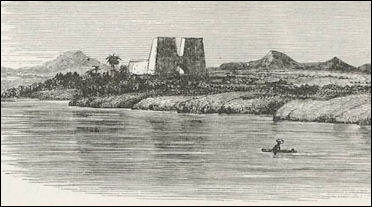
Nile in southern Egypt The Nile in modern Egypt extends for about 1,000 kilometers (600 miles) between Aswan in southern Egypt to the Mediterranean Sea. South of Aswan, breaking up the river and extending south Sudan, is 490-kilometer (300-mile) -long Lake Nasser, a reservoir created by the Aswan High Dam. The Nile is made up of the Blue Nile (originating in Ethiopia) and the White Nile (originating in Burundi in Central Africa) which combine to form the Nile in the Sudan. North of Cairo is the Nile Delta. Here the Nile splits several tributaries, the largest ones being the Rosseta
The Nile River is the longest river in the world as every school child knows. Extending for 6,670 kilometers (4,145 miles) from its source in the central African to the Mediterranean Sea, its drainage area encompasses nearly a tenth of Africa and covers an estimated 3,500,000 square kilometers (1,293,000 square miles) in nine countries. According to the Guinness Book of Records, if the Pará estuary is counted, the Amazon is 7,910 kilometers (4,195 miles) long, which make it longer mile Nile River, which lost a few miles after the construction the Aswan Dam. The flow of the Amazon is 60 times greater than the flow of the Nile.
The Nile begins in places with abundant rain but passes through areas that are dry and barren. In these places the Nile is like a long oasis bringing water, food, and life to places that otherwise would have none of these things. An ancient Egyptian hymn goes: “Hail to you, O Nile, rushing from the earth and giving life to Egypt.” Without the Nile, Ancient Egypt may never have become the great civilization it became nor lasted as long as it did.
Sailors say the traffic on the Nile can be almost as bad as traffic on the streets of Cairo. On the Nile delta most boats move only at night because the drawbridges are only open after dark. One journalist wrote, "When a bridge finally opened, the effect was of dynamite on a log jam, but with a difference: As the span lifted, everything rushed through — to meet headlong with a jam coming the other way. In the blackness of the river the result was bedlam.♬
See Separate Article: THE NILE AND ANCIENT EGYPT africame.factsanddetails.com
RECOMMENDED BOOKS:
“The Nile: Traveling Downriver Through Egypt's Past and Present” by Toby Wilkinson (2015) Amazon.com;
“The Nile: History's Greatest River” by Terje Tvedt (2021) Amazon.com;
“The Gift of the Nile?: Ancient Egypt and the Environment (Journal of Ancient Egyptian Interconnections) by Egyptian Expedition, Thomas Schneider, Christine L. Johnston (2020) Amazon.com;
“Domestication of Plants in the Old World: The Origin and Spread of Cultivated Plants in West Asia, Europe, and the Nile Valley” by Daniel Zohary and Maria Hopf (2001) Amazon.com;
“The Nile and Ancient Egypt: Changing Land- and Waterscapes, from the Neolithic to the Roman Era”, Illustrated by Judith Bunbury (2019) Amazon.com;
“The Rise and Fall of Ancient Egypt” by Toby Wilkinson (2010) Amazon.com; Wilkinson is a fellow of Clare College at Cambridge University;
“Atlas of Ancient Egypt” by John Baines (1991) Amazon.com;
“Ancient Egypt” by Salima Ikram (2013) Amazon.com;
“Ancient Egypt: An Illustrated Reference to the Myths, Religions, Pyramids and Temples of the Land of the Pharaohs” by Lorna Oakes (2002) Amazon.com;
“Ancient Egypt” (DK Eyewitness Books) by George Hart (2004) Amazon.com;
“Ancient Egypt: Anatomy of a Civilization” by Barry Kemp (1989, 2018) Amazon.com;
“The Great Book of Ancient Egypt: in the Realm of the Pharaohs” by Zahi Hawass, Illustrated (2007, 2019) Amazon.com;
“Temples, Tombs, and Hieroglyphs: A Popular History of Ancient Egypt” by Barbara Mertz (1978, 2009) Amazon.com;
“Egypt” (Insiders) by Joyce Tyldesley (2001) Amazon.com;
Nile River and History
The present Nile is only about 30,000 years old. It was preceded by at least four other versions of the river that were nourished when the Sahara was not a desert. In 1958, scientists using radioisotopes tracked a crypto-river flowing under the Nile with an annual flow of 20 trillion cubic feet — six times greater than the Nile itself.
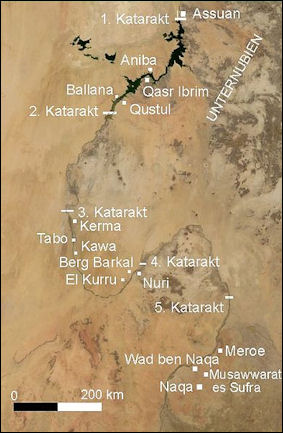
The Nile in central Nubia (Sudan) The ancient Egyptians regulated their lives according to flooding cycles of the Nile. They relied on the flooding to fertilize their farms but also suffered when high water carried away their homes and property. The ancient Egyptians believed the Nile was sacred, partly because they had no idea how the river's life-giving floodwaters could mysteriously appear every year out of a barren desert. They didn't know where the river started, and they assumed the water had to be a gift from the gods.
According to Egyptian mythology, the Nile divided the world in two, while the Nile itself was compared to a lotus: with the Nile as the flower, the oasis of Al-Faiyum as the bud; and the Nile Valley as the stem. The Greek historian Herodotus described Egypt as the "the gift of the Nile."
Millennia of floods, droughts and silt deposits have shifted the Nile eastward. Memphis, the seat of the pharaohs, literally, grew in the direction of the Nile as it moved. In the 2nd century the Greek geographer Ptolemy suggested that Nile originated in the mythical Mountain of the Moon in Africa, but no one got close to the real source until the end of the 19th century when British explorer John Speke suggested than it started in Lake Victoria. Later expeditions showed he was close — the actual source is a stream in Burundi that empties into the Kagera River, which, after 250 miles, flows into Lake Victoria.
The construction of the Aswan Dam dramatically altered the character of the Nile in Egypt. Lake Nasser, which was produced by the dam. submerged the second cataract and turned the southern section of the river in Egypt into a 300-mile long reservoir. The dam brought an end to the annual floods but it has also robbed the land of the fertile silt deposited on the farm land each year by the floods.
Nile Route
Rains that fall in nine modern nations — Egypt, Sudan, Ethiopia, Tanzania, Uganda, Kenya, the Democratic Republic of the Congo (Zaire), Burundi and Rwanda, more than 10 percent of Africa — drain into the Nile. About 85 percent of headwater are in Ethiopia.
The Nile is made up of three major tributaries — the White Nile, the Blue Nile and the Atbara. The source of the White Nile a spring in Burundi that feeds the Kagara River in Rwanda, which in turn flows into Lake Victoria. The source of the Blue Nile is near Lake Tana, Ethiopia. The Atbara River contributes one-fifth of the Nile — s volume during floods. The last major tributary of the Nile, it originates in the highlands of northwestern Ethiopia, flows through Sudan and joins the Nile 200 miles upstream from Khartoum.
The Blue Nile begins at Lake Tana, a large Rift Valley lake in central Ethiopia surrounded by Coptic monasteries. After tumbling over Blue Nile Falls, the river winds through a steep gorge in the Central Ethiopian Plateau that is a mile deep. The source of floodwaters in Egypt are the annual rains that fall on Ethiopia and empty into the Blue Nile and Atbara, Much of the fertile silt in the Nile is top soil that washes down from the Ethiopian highlands.
White Nile
The White Nile is the longest of the three Nile tributaries. It winds through Uganda and descends 1,700 feet between Lake Victoria and Lake Albert on the Zaire border. Along the way the White Nile flows though Muchinson Falls, where the river narrows from a width of a half a mile to a few hundred meters and then shots through 20-foot-channel like a foaming white "hydraulic explosion." The Albert Nile, which originates in the Ruwenzori mountains, flows into Lake Albert.
In the Bahr el Jebel region of the Sudan the river spreads out in vast unnavigable swamp filled with papyrus reeds and elephants grass. One British explorer called it a “horrible region of everlasting swamp.” The water moves so slowly in this 500 mile long region that half the river evaporates into the sky or seeps into the soil. The 225-mile Jonglei Canal was designed to reduce water loss from the evaporation and bring water to 400,000 acres of land. Construction was halted due to the civil war in the Sudan.
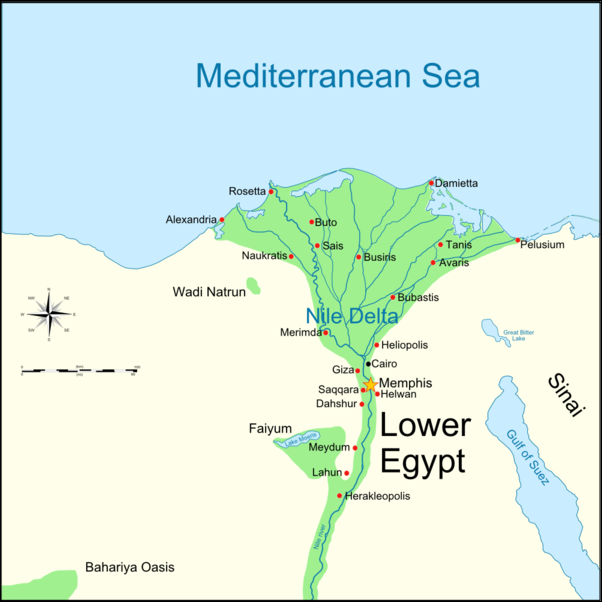
Lower Egypt
Nile After Khartoum
At Khartoum the roughly 2200 mile-long White Nile joins the 850-mile-long Blue Nile to form the Nile proper. The Nile is an important transportation route in Sudan. Waters from the Nile in this barren region are harnessed for irrigation.
The Nile receives its last great tributary the Blue Nile, near what is now Khartoum, at about 17̊ latitude. North of Khartoum the river flows quietly through grassy plains; below; further on it changes its peaceful character, as it makes its way through the great table-land of the north of Africa. There is an immense S-shaped bend of over 1,700 kilometers (1,050 miles) that forces a passage through the Nubian sandstone. In some places where the harder stone emerges through the sandstone, the river, even after thousands of years, has not succeeded in completely breaking through the barrier, and the water finds its way in rapids between the hard rocks. [Source: Life in Ancient Egypt by Adolph Erman, 1894]
North of Khartoum the Nile is interrupted briefly by six cataracts (areas of rapids and granite outcroppings). Numbered in ascending order from north to south, the cataracts make the river unnavigable between Lake Nasser in southern Egypt and Khartoum in central Sudan. Between the First Cataract, not far from Aswan, and Cairo the river is navigable but often times the river is so shallow that the only boats that can negotiate it are flat-bottomed fellucas. North of Cairo the river separates into scores of channels in the approximately 100-mile-wide Nile Delta.
Nile Valley
The Nile Valley is a flat flood plain that follows the Nile over the length of Egypt from north to south. Described as a 600-mile-long oasis, it is 930 miles (if Lake Nasser is included) and averages two miles in width. It makes up only 3 percent of Egypt’s land but is home to 96 percent of Egypt’s population. In many places it is flanked by escarpments and cliffs. Many temples and tombs have been placed on top of these. The majority of Egyptians live around the Nile. For them the desert is almost as alien an environment as snow-capped mountains.
In Egypt the Nile flows through land that receives almost no rain. The river provides water for crops such as cotton, sugar, rice and is the life force for millions of people. When viewed from an airplane the Nile valley looks like a green ribbon surrounded by endless deserts. In some places the cultivated area is limited by escarpments. In other places where the land is flat and no escarpments are present irrigation has extended agricultural land outward from the river for miles.
Many of the people who live around the river live in villages that have been unchanged by the centuries. The residents dress in robes and turbans as their ancestors have centuries and till the soil and irrigate their crops using traditional methods.
According to Minnesota State University, Mankato: “The geography of Egypt is deeply important in understanding why the Egyptians centered their lives around the Nile. Both before and during the use of canal irrigation in Egypt, the Nile Valley could be separated into two parts, the River Basin or the flat alluvial (or black land soil), and the Red Land or red desert land. The River basin of the Nile was in sharp contrast to the rest of the land of Egypt and was rich with wild life and water fowl, depending on the waxing and waning cycles of the Nile. In contrast, the red desert was a flat dry area which was devoid of most life and water, regardless of any seasonal cycle.” [Source: Minnesota State University, Mankato, ethanholman.com]
Nile Route Between Luxor (Thebes) and Cairo (Memphis)
In ancient Egypt a “nome” was the equivalent of a province. Sailing northward, downstream from Thebes, we come on the eastern bank to the "Nome of the Two Hawks," an important in old and modern days for the same reason. The river here makes a deep bend towards the Red Sea, and is met by a transverse valley of the Arabian desert which forms a natural road from Egypt to the coast. The Egyptian expeditions to the incense country of Punt, the Greek merchantmen traveling to South Arabia, the Indian navigators of the Middle Ages, the modern pilgrims to Mecca, all have used this road; and it is only since the opening of the Suez Canal that traffic has been wholly diverted into another route. The starting-points for the desert, and the harbours, have changed from time to time; Gebtu (Qift, Koptos) was the usual starting-point in ancient times. [Source: Life in Ancient Egypt by Adolph Erman, 1894]
In old times this road was also important for the great quarries of Wadi Hammamat, situated where the limestone meets the older formations. With the exception of granite, much of the hard dark-coloured stone used by the Egyptian sculptors came from these quarries; and those who know how much the Egyptians valued these " eternal stones " can estimate the importance of the road by which alone they could obtain these treasures. Soldiers protected it from the Bedouins who are said to have attacked travelers. A higher protection than the soldiers was also at hand, for Gebtu was the abode of the great god Min.
About 60 kilometers (38 miles) downstream in the 8th nome, was one of the most holy places in Egypt — Abydos, with its temple for Osiris. The 10th and 11th nomes both lay on the western bank. Here was the entrance of one of the great desert roads which led to the porphyry quarries in the northern part of the Arabian desert. Traffic also passed along this road, and across the Gulf of Aqaba to the quarries in the peninsula of Sinai; this was an easier route than that by sea from Lower Egypt. The 12th nome on the eastern bank was the chief seat of the worship of Anubis, the jackal-headed god of the dead.
We next come to the 15th province and Amarna, the city of Akhenaten founded about 1340 B.C. Further on, Anubis was the primary god in the 17th and 18th nomes. These provinces played little part in political history, least of all the 18th, where there was little arable land, but to which belonged the celebrated alabaster quarries lying in the mountains at the distance of about a day's journey. The 19th nome to the west of the Nile. On the west side there follow the anterior and posterior Nomes of the Date Palm (the 20th and the 21st), both famous in the Old Egypt Kingdom. The fertile Faiyum Oasis belonged to the posterior nome, and the water reservoirs here were most important for all of Egypt. Whilst the other oases lie 32 to 49 kilometers (20 or 30 miles) from the Nile, and arc watered by springs, the Faiyum is connected with the Nile by a canal, and is close to the edge of the western valley, the traveler in fact can cross the intervening mountainous district in little more than an hour.
The Bahr Yussef ("the waterway of Joseph") is a canal which connects the Nile River with Faiyum Oasis in Egypt. It makes a bend away from the Nile, and flows northwards to the western side of the valley. This is not totally an artificial canal, as is proved by its many curves and bends, but was made from old branch of the river. Herodotos said that the present eastern channel of the Nile was not the ancient one; the latter formerly flowed close to the western edge of the valley. This great change was probably due to no sudden act of nature. It is well known that a river left to itself, with no rocky walls to stop it, will slowly shift its bed, and sometimes, after forming a new branch may even for centuries allow its waters to flow through both branches equally before it entirely gives up the old channel, in which the water gradually subsides until the watercourse is left dry.
The inundation in the Faiyum and in Lower Egypt was regulated; for if the water rose too high, part was retained in this deep lake, if too low, some of the reserve water could be used from it. It was natural that in this lake region people revered the crocodile-headed god Sobek, whose temple was to be found in Faiyum. The two nomes of the Date Palm, and the unimportant nome opposite (the 23rd), complete the provinces of " the South " or Upper Egypt.
Nile Delta
 The Nile Delta is a flat expanse of extremely fertile land covered with green fields and laced with canals. Covering about 6,000 square miles, it has such a perfect triangular shape that the ancient Greeks coined the world "delta" to describe it because they were reminded of a Greek letter by the same name. The ancient Egyptians also had a major presence here. Some scholars believed that Menes I conquered Lower Egypt and unified Egypt to get his hands on the Delta. Jews believe that the delta was Goshen, the "house of bondage" where the Israelites labored for the pharaoh before they were led to the promised land by Moses.
The Nile Delta is a flat expanse of extremely fertile land covered with green fields and laced with canals. Covering about 6,000 square miles, it has such a perfect triangular shape that the ancient Greeks coined the world "delta" to describe it because they were reminded of a Greek letter by the same name. The ancient Egyptians also had a major presence here. Some scholars believed that Menes I conquered Lower Egypt and unified Egypt to get his hands on the Delta. Jews believe that the delta was Goshen, the "house of bondage" where the Israelites labored for the pharaoh before they were led to the promised land by Moses.
The Nile Delta is about a 100 miles in length from north to south and 150 miles wide at its widest point. North of Cairo the Nile splits into several tributaries, the largest ones being the Rosseta and Damietta branches, which empty into the Mediterranean Sea near ports with the same names.
In many ways life on delta today has changed remarkably little since Biblical times. Most peasants still use cattle plows instead of tractors to cultivate their land. Water wheels and Archimedes screws are used instead of pumps to lift water from the Nile. However, more and more, traditional saqia irrigation wheels are being replaced by diesel pumps.
The Nile Delta is one of the world's most intensely cultivated piece of land. Almost every inch of the region cultivated. The land is divided into fields and canal chocked with hyciths and papyrus. There are cotton fields, rice paddies, wheat fields, grape arbors, and fields with leafy vegetables, beets, melons, broad beans, potatoes, and squashes. Of Egypt's 7.5 million acres of arable land, 6 million acres is in the Nile Delta.
Over a million people now live in the Nile Delta area, along with thousands of water buffalo, donkeys and thousands of migratory birds (up until 1980, 25 percent of all the wetlands in the Mediterranean was in the Nile Delta). The Egyptians that live in the delta area are known for their industriousness. [Source: Peter Theroux, National Geographic, January 1997]
Nile Delta in Ancient Egypt
The west of the Delta was probably inhabited chiefly by Libyans, one town only being frequently mentioned in ancient times, Sais, the city of the goddess of war, Neith. In the eighth century B.C. this town first became of historical importance, the Libyan family reigning there, certain chiefs of the names of Psammetichus and Necho having raised themselves to be kings of Egypt. [Source: Life in Ancient Egypt by Adolph Erman, 1894]
The east of the Delta was more thickly populated; at Mendes, the sacred ram was revered; at Busiris there was a famous temple of Osiris; at Bubastis there were Dionysian festivals for the cat-headed goddess of pleasure. Bastet. To the north-east, on the edge of the swamps, was Tanis, an important town even in very ancient times. NonEgyptian rulers seem to have reigned there in old times; later kings also resided here and built a great temple to the warrior god Seth. Mariette excavated the vast ruins here in mid 19th century.
Near Zagazig are the ruins of Bubastis, one of the oldest ancient cities in Egypt and the center of an ancient cat cult. Some 40 miles northeast of Zagazig near the village of San el Hagar are the ruins of Tanis, where statues of pharaohs were stored and many scholars believe the Hebrews were enslaved. Rashid (40 miles east of Alexandria) is where the Rosetta Stone was found by Napoleon's soldiers in 1799. It is located where the western Rosetta branch of the Nile empties into the Mediterranean.
Nile Flooding and Fertility
The water in the Nile is generally very shallow but goes through periods of flooding caused mostly by heavy rains in Africa, particularly in the Ethiopian highlands. First the White Nile floods, then the Blue Nile and its tributaries. The flood waters reach Egypt in late spring and rise through the summer until they reach their peak in September or October and then decline until November.
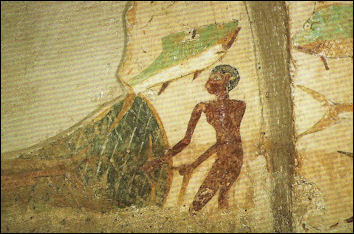
fishing The water level of Nile fluctuates as much as 10 feet a year. Water levels are at their lowest around July when seasonal rains are late in Africa. Describing the flood season Herodotus wrote: “Only the towns remain above water, looking rather like the islands of the Aegean.” The Nile floods used to deposit as much as 20 million tons of silt on fields along the river every year. As the floods recede the water drains through the soil, leaching out the salts and carrying them off to the sea.
The Nile receives quite a bit of water from the high mountains of Ethiopia. During the rainy season mountain torrents, laden with rocky sediments, flow into the two great streams of the Blue Nile and the Atbara which flow into the Nile. By the middle of the summer the river gradually rises so high that the banks can no longer contain the vast quantity of water and mud. The river overflows slowly, and after some months slowly retreats again into its bed. While the water of the inundation covers the valley the mud in the water is of course deposited, and when the stream has retreated, the country is left covered with a thin coating of this mud composed of the finest stone dust from the Abyssinian mountains; it is this black Nile mud which has caused, and which renews each year, the fertility of Egypt. It now forms the soil of Egypt; and from Khartum to the sea the deposit of mud in the valley has reached the height of 30 feet, and in this mud the Nile has hollowed its present bed.
Inundation of the Nile
The Nile in it's natural state goes through periods of inundation and recession. The inundation of the Nile — a slightly unpredictable event — was the time of greatest fertility for Egypt. As the banks rose, the water would fill the man-made canals and canal basins and would water the crops for the coming year. However, if the inundation was even 50 centimeters (twenty inches) above or below normal, it could have massive consequences upon the Egyptian agricultural economy. Even with this variability, the Egyptians were able to easily grow tree crops and vegetable gardens in the lower part of the Nile Valley, while at higher elevations, usually near levees, the Nile Valley was sparsely planted.” [Source: Minnesota State University, Mankato, ethanholman.com]
According to Plumbing & Mechanical Magazine: “From ancient times, the rise and fall of the River Nile portended periods of famine or good fortune for the peoples of Egypt. Other than wells, the River Nile is the only source of water in the country. During an idyllic year, the flooding of the Nile would begin in July, and by September its receding waters would deposit a rich, black silt in its wake for farming. Before taming the river, however, the ancient Egyptians had to overcome the river’s peculiar problem. The Nile runs along an alluvial plain, the ebb and tide of the Nile corresponding to an annual movement of the ground. When the Nile is the lowest, the ground completely dries up. When it floods, the water seeps into the dry soil and causes the ground to rise as much as a foot or two like some bloated sponge. As the inundation subsides the ground settles again to its original dry level, but never settles evenly.” [Source: Plumbing & Mechanical Magazine, July 1989, theplumber.com]
The Nile typically begins to rise in the beginning of June; it becomes a mighty torrent by the end of July; from the end of September to the end of October the water reaches its highest level, after which time it retreats more and more rapidly. In January the stream is back once more in its old bed, but it goes on subsiding till the summer. This inundation spreads coolness, dampness, and fertility. It helps Egypt revive during the summer heat. We can easily understand why the ancient Egyptians fixed their New Year's Day on the 15th of September, around the time of the Nile was at its highest. [Source: Life in Ancient Egypt by Adolph Erman, 1894]
Nile Agriculture
The Nile loses up to 95 percent of it water (compared to 1 percent of the Rhone), most of it for agriculture. The area around the Upper Nile receives only three to five millimeters of rain a year. In ancient times there was a system of dykes that diverted water into basins. When the river flooded water filled the basins. When the water left fertile silt was left behind. To get water to agriculture land a number of pumping stations have been built along the Nile.
John Baines of the University of Oxford wrote: “The Nile's annual inundation was relatively reliable, and the floodplain and Delta were very fertile, making Egyptian agriculture the most secure and productive in the Near East. When conditions were stable, food could be stored against scarcity. The situation, however, was not always favourable. High floods could be very destructive; sometimes growth was held back through crop failure due to poor floods; sometimes there was population loss through disease and other hazards. Contrary to modern practice, only one main crop was grown per year. [Source: John Baines, BBC, Professor of Egyptology at the University of Oxford, February 17, 2011 |::|]
“Crops could be planted after the inundation, which covered the Valley and Delta in August and September; they needed minimal watering and ripened from March to May. Management of the inundation in order to improve its coverage of the land and to regulate the period of flooding increased yields, while drainage and the accumulation of silt extended the fields. Vegetables grown in small plots needed irrigating all year from water carried by hand in pots, and from 1500 B.C. by artificial water-lifting devices. Some plants, such as date palms, whose crops ripened in the late summer, drew their water from the subsoil and needed no other watering. |::|
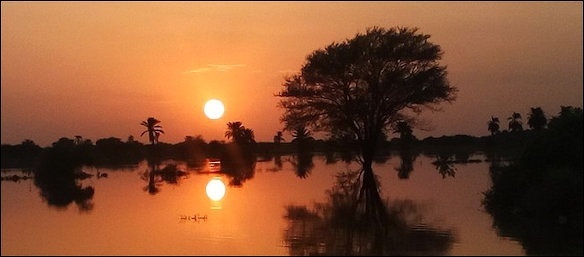
flooding of the Nile at sunset
Image Sources: Wikimedia Commons, The Louvre, The British Museum, The Egyptian Museum in Cairo
Text Sources: UCLA Encyclopedia of Egyptology, escholarship.org ; Internet Ancient History Sourcebook: Egypt sourcebooks.fordham.edu ; Tour Egypt, Minnesota State University, Mankato, ethanholman.com; Mark Millmore, discoveringegypt.com discoveringegypt.com; Metropolitan Museum of Art, National Geographic, Smithsonian magazine, New York Times, Washington Post, Los Angeles Times, Discover magazine, Times of London, Natural History magazine, Archaeology magazine, The New Yorker, BBC, Encyclopædia Britannica, Time, Newsweek, Wikipedia, Reuters, Associated Press, The Guardian, AFP, Lonely Planet Guides, “World Religions” edited by Geoffrey Parrinder (Facts on File Publications, New York); “History of Warfare” by John Keegan (Vintage Books); “History of Art” by H.W. Janson Prentice Hall, Englewood Cliffs, N.J.), Compton’s Encyclopedia and various books and other publications.
Last updated July 2024
